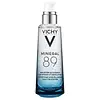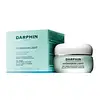What's inside
What's inside
 Key Ingredients
Key Ingredients

 Benefits
Benefits

 Concerns
Concerns

No concerns
 Ingredients Side-by-side
Ingredients Side-by-side

Water
Skin ConditioningGlycerin
HumectantDimethicone
EmollientPolysorbate 60
EmulsifyingCetyl Palmitate
EmollientPropanediol
SolventHydrogenated Polydecene
EmollientSorbitan Stearate
EmulsifyingSqualane
EmollientImperata Cylindrica Root Extract
Skin ConditioningTridecyl Stearate
EmollientCucumis Sativus Fruit Extract
EmollientActinidia Chinensis Fruit Extract
EmollientSalicornia Herbacea Extract
Skin ConditioningLavandula Stoechas Extract
MaskingTridecyl Trimellitate
EmollientButylene Glycol
HumectantTocopheryl Acetate
AntioxidantDipentaerythrityl Hexacaprylate/Hexacaprate
EmulsifyingPanthenol
Skin ConditioningAcrylates/C10-30 Alkyl Acrylate Crosspolymer
Emulsion StabilisingCaprylic/Capric Triglyceride
MaskingEthylhexylglycerin
Skin ConditioningDimethiconol
EmollientHydrogenated Vegetable Oil
EmollientHydroxyethyl Acrylate/Sodium Acryloyldimethyl Taurate Copolymer
Emulsion StabilisingIsohexadecane
EmollientSodium Hyaluronate
HumectantCaprylyl Glycol
EmollientSodium Hydroxide
BufferingCarbomer
Emulsion StabilisingTetrasodium EDTA
Sodium Benzoate
MaskingChlorphenesin
AntimicrobialParfum
MaskingAlpha-Isomethyl Ionone
PerfumingLimonene
PerfumingButylphenyl Methylpropional
PerfumingHexyl Cinnamal
PerfumingLinalool
PerfumingHydroxyisohexyl 3-Cyclohexene Carboxaldehyde
MaskingHydroxycitronellal
PerfumingCitronellol
PerfumingBenzyl Benzoate
AntimicrobialCitral
PerfumingGeraniol
PerfumingCI 19140
Cosmetic ColorantCI 42090
Cosmetic ColorantWater, Glycerin, Dimethicone, Polysorbate 60, Cetyl Palmitate, Propanediol, Hydrogenated Polydecene, Sorbitan Stearate, Squalane, Imperata Cylindrica Root Extract, Tridecyl Stearate, Cucumis Sativus Fruit Extract, Actinidia Chinensis Fruit Extract, Salicornia Herbacea Extract, Lavandula Stoechas Extract, Tridecyl Trimellitate, Butylene Glycol, Tocopheryl Acetate, Dipentaerythrityl Hexacaprylate/Hexacaprate, Panthenol, Acrylates/C10-30 Alkyl Acrylate Crosspolymer, Caprylic/Capric Triglyceride, Ethylhexylglycerin, Dimethiconol, Hydrogenated Vegetable Oil, Hydroxyethyl Acrylate/Sodium Acryloyldimethyl Taurate Copolymer, Isohexadecane, Sodium Hyaluronate, Caprylyl Glycol, Sodium Hydroxide, Carbomer, Tetrasodium EDTA, Sodium Benzoate, Chlorphenesin, Parfum, Alpha-Isomethyl Ionone, Limonene, Butylphenyl Methylpropional, Hexyl Cinnamal, Linalool, Hydroxyisohexyl 3-Cyclohexene Carboxaldehyde, Hydroxycitronellal, Citronellol, Benzyl Benzoate, Citral, Geraniol, CI 19140, CI 42090
 Reviews
Reviews

Ingredients Explained
These ingredients are found in both products.
Ingredients higher up in an ingredient list are typically present in a larger amount.
Butylene Glycol (or BG) is used within cosmetic products for a few different reasons:
Overall, Butylene Glycol is a safe and well-rounded ingredient that works well with other ingredients.
Though this ingredient works well with most skin types, some people with sensitive skin may experience a reaction such as allergic rashes, closed comedones, or itchiness.
Learn more about Butylene GlycolCaprylyl Glycol is a humectant and emollient, meaning it attracts and preserves moisture.
It is a common ingredient in many products, especially those designed to hydrate skin. The primary benefits are retaining moisture, skin softening, and promoting a healthy skin barrier.
Though Caprylyl Glycol is an alcohol derived from fatty acids, it is not the kind that can dry out skin.
This ingredient is also used as a preservative to extend the life of products. It has slight antimicrobial properties.
Learn more about Caprylyl GlycolCarbomer is a polymer of acrylic acid. Its main role is to create a gel consistency.
A high amount of carbomer can cause pilling or balling up of products. Don't worry, most products contain 1% or less of carbomer.
Glycerin is already naturally found in your skin. It helps moisturize and protect your skin.
A study from 2016 found glycerin to be more effective as a humectant than AHAs and hyaluronic acid.
As a humectant, it helps the skin stay hydrated by pulling moisture to your skin. The low molecular weight of glycerin allows it to pull moisture into the deeper layers of your skin.
Hydrated skin improves your skin barrier; Your skin barrier helps protect against irritants and bacteria.
Glycerin has also been found to have antimicrobial and antiviral properties. Due to these properties, glycerin is often used in wound and burn treatments.
In cosmetics, glycerin is usually derived from plants such as soybean or palm. However, it can also be sourced from animals, such as tallow or animal fat.
This ingredient is organic, colorless, odorless, and non-toxic.
Glycerin is the name for this ingredient in American English. British English uses Glycerol/Glycerine.
Learn more about GlycerinSodium Hyaluronate is hyaluronic acid's salt form. It is commonly derived from the sodium salt of hyaluronic acid.
Like hyaluronic acid, it is great at holding water and acts as a humectant. This makes it a great skin hydrating ingredient.
Sodium Hyaluronate is naturally occurring in our bodies and is mostly found in eye fluid and joints.
These are some other common types of Hyaluronic Acid:
Learn more about Sodium HyaluronateWater. It's the most common cosmetic ingredient of all. You'll usually see it at the top of ingredient lists, meaning that it makes up the largest part of the product.
So why is it so popular? Water most often acts as a solvent - this means that it helps dissolve other ingredients into the formulation.
You'll also recognize water as that liquid we all need to stay alive. If you see this, drink a glass of water. Stay hydrated!
Learn more about Water